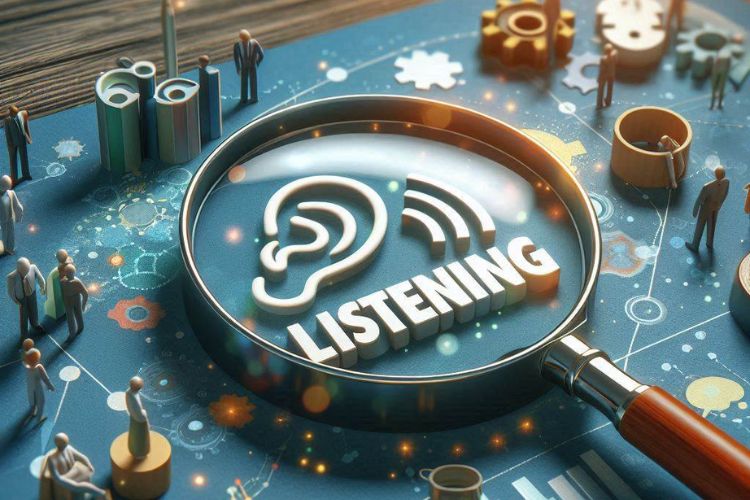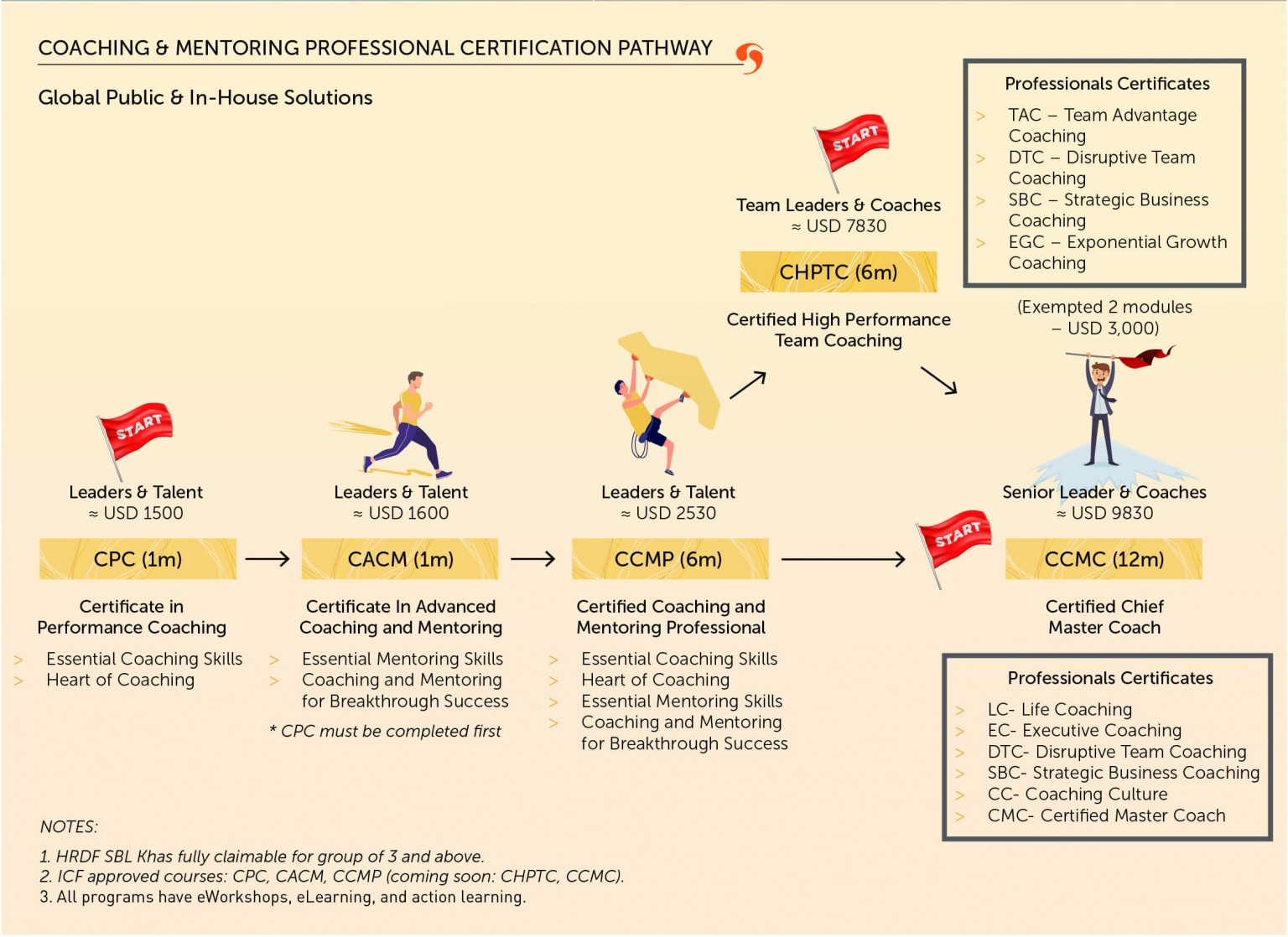Our guide on active listening will equip the knowledge skills to build rapport, foster trust, and empower people for transformative growth!
In today’s fast-paced, digitally driven world, effective communication is more crucial than ever. While we often focus on expressing ourselves clearly, the often-overlooked counterpart – active listening – is equally vital for building strong relationships, fostering understanding, and achieving success in both personal and professional spheres.
|
Author: Jonathan M. Pham |
Highlights
- Active listening involves fully concentrating on the speaker, including their verbal and nonverbal cues, and responding in a way that demonstrates understanding and empathy. This skill is crucial for effective leadership, informed decision-making, enhanced problem-solving, improved relationships and communication, effective performance management, and better conflict resolution.
- In coaching sessions, coaches may utilize techniques such as clarifying, using non-verbal communication, paraphrasing, summarizing, and asking open-ended questions to demonstrate that they are actively listening to the coachees.
- Practicing mindful listening is typically challenging due to reasons such as personal biases and distractions, emotional triggers, and the temptation to multitask. To overcome these problems, coaches should aim to foster self-awareness (through methods like meditation), seek feedback from others, take breaks when overwhelmed, and look for common ground in conversations.
- To improve active listening skills, one should take notes, practice deep breathing, cultivate active curiosity, quiet the mind, and monitor their speaking-listening ratio.
What is Active Listening?
Active listening is the practice of paying full attention to the speaker – and responding in a way that shows you understand/ empathize with what they are saying. The process involves more than just hearing words; it requires delicate consideration of nonverbal cues, such as body language and tone of voice.
| Active Listening |
Passive Listening
|
| Requires full attention and focus |
Involves minimal engagement
|
| Actively seeks to understand |
Simply receive the information
|
| Responds and shows understanding |
Offers limited or no response
|
| Uses nonverbal cues effectively |
Lacks active nonverbal engagement
|
| Asks clarifying questions |
Does not seek further clarification
|
| Reflects and paraphrases |
Does not actively reflect or paraphrase
|
| Builds rapport and trust |
May result in misunderstandings
|
| Enhances communication skills |
May lead to miscommunication
|
| Supports deeper connection |
Establishes surface-level connection
|
| Encourages active participation |
Encourages passive reception
|
In an era where failure to pay attention has become a norm in every aspect of work and life, the ability to listen attentively has become a highly sought after skill – one that can massively propel us to greater heights.
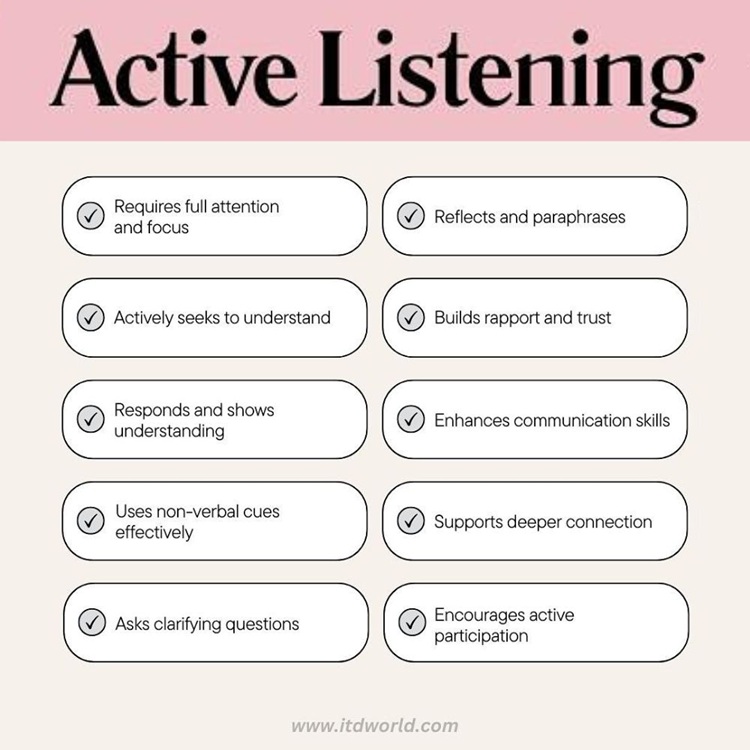
Components of Active Listening
-
Focusing on the speaker
The key component of active listening is to give the speaker your whole undivided attention. Doing so demonstrates your interest in what they have to say – that you value their input and would like to learn more. This will encourage them to be open and transparent in sharing their story, which – in turn – should allow you to gain a more comprehensive understanding of their condition.
When engaging in conversations, it is recommended that you make use of minimal prompts (for example, ‘I see’ or ‘ah’) to show that you’re listening to the other person.
-
Being non-judgmental
A non-judgmental attitude brings about a safe sense for people to openly talk through their issues. For this to work, you are expected to set aside any preconceived notions, biases, or assumptions about the speaker and their message.
Additionally, it also means withholding any immediate reactions – such as expressing disagreement or criticism – until you have fully comprehended the other person’s message.
-
Demonstrating empathy
Empathy is a critical component that contributes to building up a safe space for people to discuss their thoughts and feelings. It involves putting yourself in the other person’s shoes – in order to resonate with their feelings and perspectives, listening without judging, and asking as many questions as necessary to visualize the whole picture.
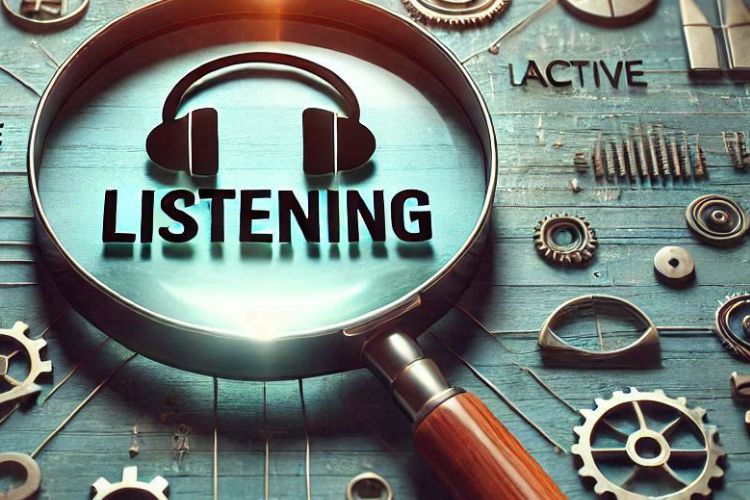
Why is Active Listening Important?
Frequent practice of active listening allows leaders to be better aware of the needs, concerns, and aspirations of their team members. As such, they become better equipped to build trust, inspire their fellows, provide support promptly, and build up a positive work environment that fosters productivity and growth for everyone involved.
- Informed decision making
Decision making is part of a leader’s daily life – and requires a comprehensive understanding of the situation at hand to produce the desired results. By attentively listening to others’ feedback, leaders are much more capable of coming up with well-informed solutions that align with the organization’s goals and values – and address the concerns of all stakeholders.
- Enhanced problem solving
When leaders actively listen to their team members, they gain more holistic insights into the challenges they face – which enables them to identify the root causes of problems and develop more effective strategies for resolving these obstacles.
Active listening promotes a collaborative atmosphere where diverse perspectives and ideas can be shared, leading to innovative and creative solutions. By involving team members in the problem-solving process, leaders not only improve the quality of the solutions – but also foster a sense of ownership and commitment among the team, ultimately driving higher levels of engagement and success.
- Improved relationships & communication
In a workplace setting, actively listening to team members’ ideas and concerns is essential to promoting open dialogue, encouraging diverse perspectives, and enhancing the overall collaboration within the team.
- Effective performance management
Another strong benefit of practicing this interpersonal skill is that it allows managers to come up with more specific, actionable constructive feedback that support employees in unlocking their professional potential. Instead of generic input, they may now be equipped to provide targeted, relevant guidance specifically tailored to each team member’s individual needs and goals.
Those who feel heard and understood are more likely to be motivated, engaged, and committed to their work. They are more willing to take on new challenges, contribute innovative ideas, and strive for continuous improvement.
- Better management & resolution of conflicts
Conflicts are inevitable in the workplace, and they can arise due to various reasons. That said, when individuals engage in mindful listening during conflict situations, they open up a space for transparent dialogue and understanding. By genuinely listening to each other’s perspectives, concerns, and underlying emotions, they may gain a comprehensive understanding of the root causes of the conflict – which, in turn, allows for more empathetic interaction, and reduces the likelihood of misinterpretations or further escalation.
Furthermore, active listening enables leaders to identify common ground and areas of agreement – which serve as a starting point for finding mutually beneficial solutions. When all parties are involved in the resolution process, it facilitates a sense of ownership and commitment to the agreed-upon solution, increasing the chances of a sustainable resolution.
Read more: The Importance of Listening for Workplace Bonds & Success
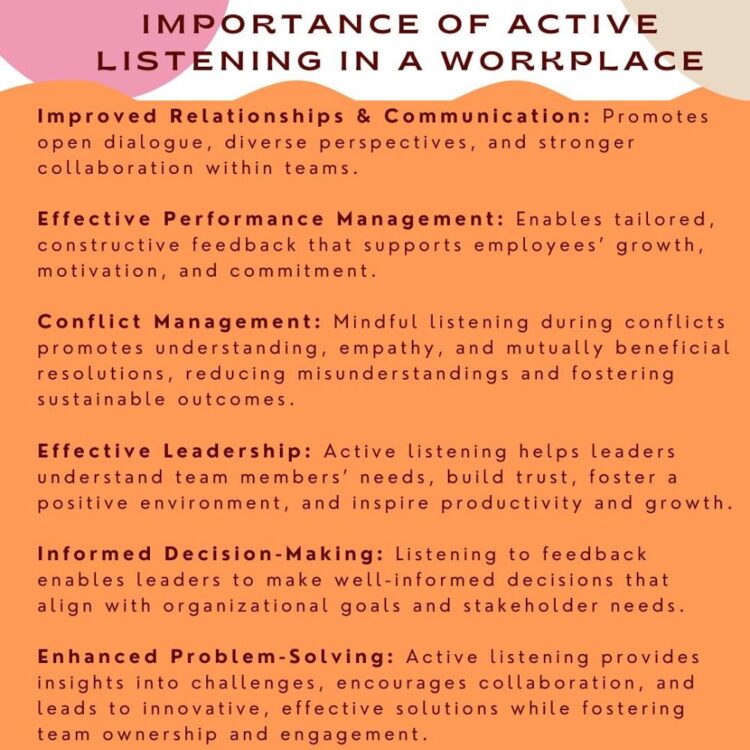
Active Listening Techniques in Coaching
Active listening is a fundamental coaching skill – it enables the establishment of mutual trust, understanding, and rapport between coaches and clients. For those who would like to adopt this practice, below are some techniques commonly utilized:
- Empathetic listening
Being empathetic means understanding and sharing the feelings of coachees. It is about doing your best to assess things from their perspective – and foster a deep, emotional connection.
For example, in a coaching session with a mid-level manager, when they express frustration with difficulty reaching their goal, the coach might say, “I understand why you might feel frustrated. It can be challenging to stay motivated when progress feels slow.” Even if you haven’t grasped the whole story, expressing empathy first will lay the foundation for gaining trust from the client.
- Clarifying
Clarify what the client meant by asking questions that require a more in-depth explanation. For example, if they say, “I’m not sure what to do next,” the coach might reply as follows, “What specifically is causing you to feel unsure?”.
Remember not to interrupt before the coachee has finished conveying their message.
- Practicing non-verbal communication
This technique involves making use of body language – to indicate that you are paying attention. Examples of non-verbal communication include nodding, maintaining eye contact, and using appropriate facial expressions.
For instance, when the client expresses a significant concern, the coach might lean forward slightly and keep eye contact – in order to demonstrate that they are being attentive.
- Paraphrasing
Simply put, this means rephrasing what the coachee says in your own words – so as to ensure that you understand the message correctly. For example, if they say, “I’m having trouble staying motivated to exercise,” the coach might respond,
“What I’m hearing is that you’re struggling to find the reasons to continue exercising. Is that correct?”
- Summarizing
Summarizing allows coaches to reinforce the key points of the conversation – as well as provides a solid foundation for follow-ups. For example, at the end of a session, the coach might recap as follows:
“Let me summarize what we discussed today. You’re struggling with time management and feeling overwhelmed with your workload. We identified a few strategies that could assist you to better manage your time, including breaking tasks into smaller steps and prioritizing your tasks.”
- Asking open-ended questions
Open-ended prompts encourage clients to provide more detailed and thoughtful responses, promoting deeper exploration of their thoughts and feelings. For example, instead of asking a closed question such as, “Did you find the information useful?” you could say something like, “How do you think about the information?” This motivates clients to reflect on their experiences, thereby facilitating meaningful conversations and allowing coaches to gain deeper insights into their clients’ inner world.
Read more: 175 Powerful Coaching Questions for Everyone
Challenges of Active Listening in Coaching
While active listening is vital in coaching, the adoption of such a practice often proves to be challenging due to reasons such as:
- Personal biases and distractions: It’s essential to be aware of your own prejudices – and avoid letting them affect your listening capability. Similarly, distractions such as cell phones and electronic devices should be left out to avoid impeding the conversation.
- Emotional triggers: As coaches are also human beings, their thinking is not only affected by logic – but also by emotions. This is why coaching can be truly challenging, and coaches must learn to refine their emotional intelligence to better control their responses to stimuli.
- Multitasking: It’s essential to focus solely on the conversation at hand. If a coach is trying to work on other tasks during a session – such as responding to emails, they cannot be fully present and engaged in the discussion with the client.

Strategies for Overcoming the Barriers to Active Listening
- Fostering self-awareness
Specifically, coaches must be aware of their personal biases and emotional triggers – so as to find ways to better manage them.
An effective method commonly adopted to foster self-awareness is meditation, which allows you to cultivate a deeper connection with your inner selves, observe your thoughts and emotions with non-judgmental awareness, and gain insights into your patterns and beliefs.
- Seeking feedback
It is recommended that coaches ask coachees directly about their experience and satisfaction with the process, including how well they felt listened to and understood. Based on their input, coaches should be provided with a more holistic awareness of how they are perceived – allowing them to identify areas for improvement.
For example, after a coaching session, coaches can ask questions like:
- How do you feel about the interaction in the previous session?
- How would you like me to receive and respond to your inputs?
The answers from the clients will help you to figure out your shortcomings and work on them. To effectively solicit feedback, ask with sincerity – and be willing to make necessary adjustments to address the coachee’s needs.
- Taking a break
When overwhelmed by emotions during a conversation, do not hesitate to take a little break. Stepping away from the situation, engaging in activities like going for a walk, listening to music, or just simply taking a deep breath allows you to regain composure – as well as helps create a calmer state of mind.
- Looking for common ground
In situations where one may not totally agree with what someone is saying, it is recommended that they do their best to search for common ground. By looking for generally accepted advice or similar experiences, coaches can establish connections and bridge gaps in understanding, facilitating more meaningful and productive conversations.
Let’s consider a workplace scenario where two people have different opinions on how to approach a project deadline. One believes that extending the timeline is necessary to ensure a high-quality outcome, while the other thinks that sticking to the original date is crucial to meet client expectations.
In this situation, active listening and looking for common ground can help foster a constructive conversation between the two. The supervisor, who advocates for extending the deadline, might say,
“I understand your concern about meeting client expectations, and I agree that it’s important. At the same time, I’ve noticed that when we rush to complete projects, the quality can suffer, and it affects our overall reputation. Can we explore potential solutions that allow us to balance both the quality and timeliness of our deliverables?”
In the example above, the person acknowledges the importance of meeting client expectations, validating the other party’s viewpoint. However, they also introduce their own concern about maintaining high-quality work, which is an area where they might find agreement.
How to Improve your Active Listening Skills
-
Take notes
Engaging in note-taking aids in maintaining focus and actively attending to your client. It serves as a “safeguard” against overlooking crucial details – as well as enables coaches to provide more precise and informed feedback.
In addition, this technique helps instill confidence in your clients, as they perceive that you are actively doing your best to understand them – thereby encouraging them to share their stories more openly.
-
Take a deep breath
Take a deep breath before you even start – in order to process the information that has been communicated to you. Often, this intentional pause should provide you with the time necessary to reflect, contemplate, and establish a genuine connection with your response.
-
Practice active curiosity
One crucial method for coaches to cultivate active listening skills is by nurturing a sense of curiosity. When we approach a conversation with genuine inquisitiveness, our attentiveness deepens, allowing us to set aside judgment and reflect back to the client what we have absorbed from them. This process fosters trust and rapport – as the client feels truly heard, that the coach possesses a sincere interest in their thoughts and experiences.
-
Quiet the mind
You cannot pour water into a full cup. Similarly, if you’re stacked up with thoughts in your head, how are you supposed to listen to what people have to say?
Calming your mind is the first step to effective listening. One effective approach to master this skill is through daily meditation. Engaging in regular meditation offers the chance to attain real-time tranquility, which is especially helpful later when you require heightened concentration during conversations.
By quieting your mind, you can actively contribute to the dialogue, creating an environment where people feel genuinely heard and valued.
Read more: Thoughtful Leadership – Why It Matters in Today’s Hectic World
-
Watch your Speaking-Listening ratio
As coaches strive to enhance their listening skills, it is vital to attentively observe the balance between speaking and listening. Embracing silence as a powerful tool entails patiently awaiting insights from within the client’s mind.
While consistently posing insightful questions to solicit information and employing reflection techniques to stay engaged, make sure to allow space for the client to provide a complete response. By maintaining this balance, coaches may foster an environment where clients feel truly heard and valued.

Enhance your Active Listening Skills with ITD’s Coaching Courses
Whether in coaching sessions or daily interactions, the skill of active listening enables us to establish positive connections, paving the way for long-term success.
ITD’s comprehensive ICF-certified coaching programs are designed to help individuals develop and strengthen their listening capabilities. Through interactive and engaging training sessions, participants will learn effective techniques and strategies to become more attentive, aware, and actively engaged listeners. Our experienced coaches will provide practical guidance and feedback, enabling you to apply these skills in real-world scenarios.
Take the next step in your professional development and enroll in ITD’s professional certification courses today!
Other resources you might be interested in:
- 9 Key Leadership Skills for the Future of Work
- Cross-Cultural Communication: A Holistic Guide
- Continuous Feedback: A Cornerstone of Modern Workplace

